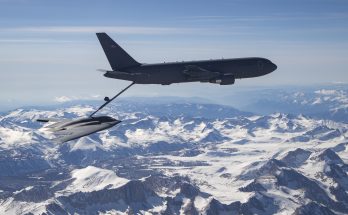by Shaun McDougall, Military Markets Analyst, Forecast International.

Source: U.S. Navy
In a shock to pundits and pollsters, the U.S. political landscape took a dramatic shift with the election of businessman Donald Trump as president. Furthermore, the Republican Party managed to hold on to power in the Senate, albeit by the slimmest of margins, giving the GOP a monopoly on power in Washington. The election results portend a shift in U.S. national security policy, and growth for a defense budget that has been hindered for years by gridlock on the Hill.
The primary obstacle to larger defense budgets during President Barack Obama’s second term has been the Budget Control Act of 2011, which established spending caps for defense and non-defense spending through FY21, and included the oft-cited sequester mechanism that would reduce funding across the board should those caps be exceeded. The Obama administration’s defense spending plans have actually exceeded defense caps in recent years, but spending has been continuously reined in due to disagreements over how to address the budget caps. Unable to agree on a permanent fix, Congress has fallen back on a pair of two-year compromise deals that provided the Pentagon with partial relief from the caps, but did nothing to eliminate the lingering budget uncertainty that has complicated planning at every level.
Trump has promised to eliminate sequestration and increase defense spending, causing a surge in defense stocks a day after the election. The president-elect wants to reverse ongoing personnel cuts for the Army and Marine Corps, increasing the active Army to 540,000 troops (up from around 475,000 today), and adding 13 Marine Corps battalions. Navy shipbuilding would see a significant boost, with Trump planning to increase the fleet to 350 ships. The Navy currently has 272 ships, with a requirement for 308 ships. Under the latest 30-year shipbuilding plan, the Navy would only meet its 308-ship requirement between FY21 and FY28. Trump said he would bolster missile defense capabilities by modernizing cruisers and buying additional DDG 51 class destroyers. He wants to increase the Air Force’s active fighter fleet to 1,200, up from around 1,113. He has also called for increased offensive and defensive cyber capabilities, and plans to launch a thorough review of U.S. cyber defenses to identify vulnerabilities.
These are very costly proposals, particularly the ground force and Navy fleet expansions, and will require a substantial increase to the DoD topline over the coming years. Trump has said he would pay for these increases by eliminating unnecessary spending, including ending “unwanted and unauthorized federal programs.” Non-defense spending will likely take a hit to offset some of these items, but others will merely be added to the debt.
Trump’s plan – and surely Trump himself – comes with a host of uncertainties. For one, although he has proposed a series of substantial force structure changes, he has not outlined a strategy to back them up. Trump’s speeches have often included isolationist rhetoric, questioning the value of alliances and calling for U.S. allies to pay more for security provided by the U.S. This brings into question how a larger ground force and Navy would actually be used on the world stage, and to what extent other nations would be expected to ramp up their own defense outlays. The U.S. military has been increasing its presence in Europe in an effort to ease concerns about Russia, while simultaneously shifting more resources to the Pacific region – all while troops remain deployed in the Middle East. It remains to be seen whether Trump will reduce the scale of deployed forces, thereby allowing a larger U.S. force to serve more as a distant deterrent than an intervention tool. Furthermore, Trump is quick to change his stance on subjects and lacks any military or foreign policy experience. This unnerving combination will amplify the significance and influence of Trump’s inner circle of advisors. He has also butted heads with elements of the GOP establishment, which could result in intraparty quarrels.
In the more immediate future, Congress is still grappling with the defense budget for FY17, which began October 1. The government is operating at FY16 funding levels under a continuing resolution that runs through December 9. House defense committees have recommended using war funding to pay for additional base budget priorities (particularly acquisition) as a way to sidestep budget caps. The Senate has not signed off on the proposal, and the White House has threatened to veto legislation that uses such tactics. Following the Republican sweep, however, the GOP will likely try to avoid a deal during the lame duck session by pushing the FY17 budget debate into early next year. The delay would allow Congress to work with Trump to push through spending increases in FY17. The change in administrations, as well as the late FY17 budget, will also delay the release of the FY18 budget. The FY18 spending plan will surely ramp up funding over the next five years, but it remains to be seen exactly how much growth Trump will inject into the Pentagon.
Please feel free to use this content with Forecast International and analyst attributions, along with a link to the article. Contact Ray Peterson at +1 (203) 426-0800 or via email at ray.peterson@forecast1.com for additional analysis.
The Forecast International International Military Markets series examines the military capabilities, equipment requirements, and force structures inventories of 140 countries, with corresponding coverage of the political and economic trends shaping the defense market outlook for individual countries and regions.
For 50 years, Forecast International intelligence reports have been the aerospace and defense industry standard for accurate research, analysis, and projections. Our experienced analysts compile, evaluate, and present accurate data for decision makers. FI's market research reports offer concise analysis of individual programs and identify market opportunities. Each report includes a program overview, detailed statistics, recent developments and a competitive analysis, culminating in production forecasts spanning 10 or 15 years. Let our market intelligence reports be a key part of reducing uncertainties and mastering your specific market and its growth potential. Find out more at www.forecastinternational.com




